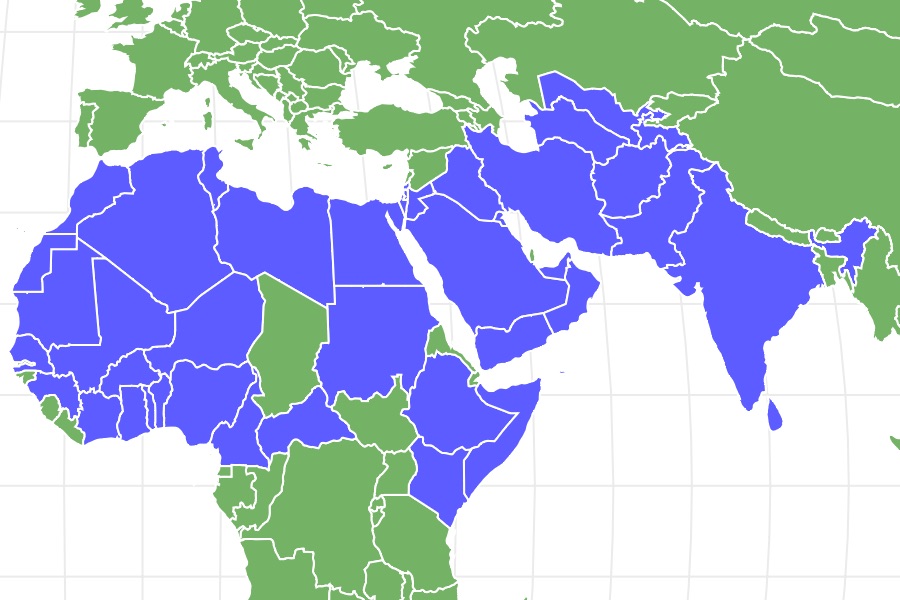Carpet Viper
The Carpet Viper probably bites and kills more people than any other species of snake.
Advertisement
Carpet Viper Scientific Classification
Read our Complete Guide to Classification of Animals.
Carpet Viper Conservation Status
Carpet Viper Facts
- Prey
- Insects, slugs, worms, scorpions, reptiles, amphibians, birds and small mammals.
- Group Behavior
- Solitary
- Fun Fact
- The Carpet Viper probably bites and kills more people than any other species of snake.
View all of the Carpet Viper images!
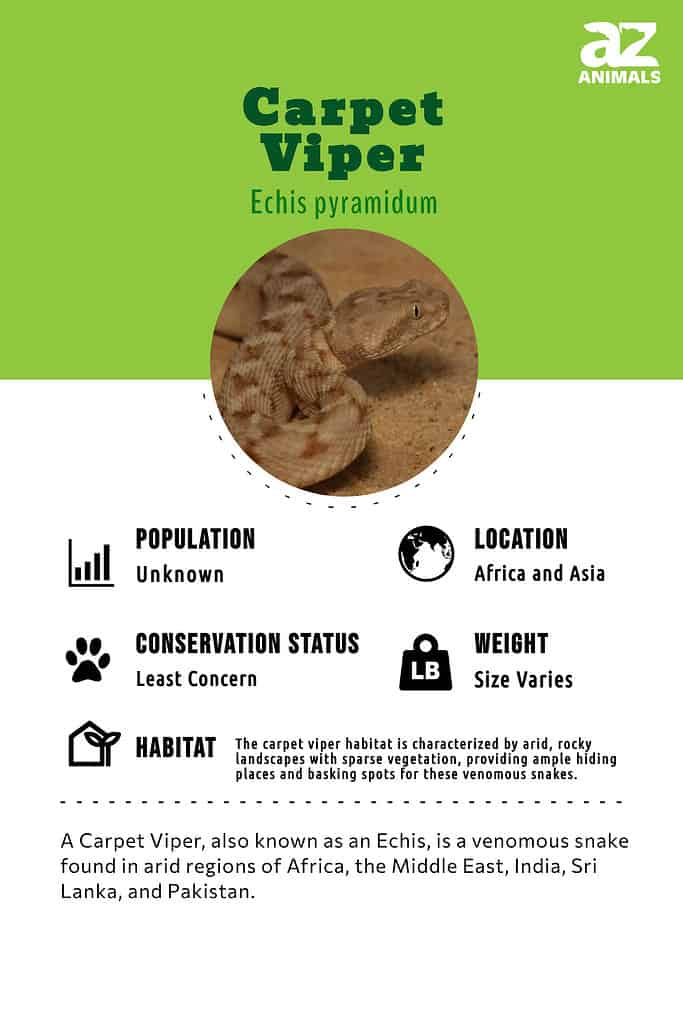
The Carpet Viper is described as “Small and Deadly”
Most people are surprised to learn that these unassuming reptiles are responsible for more snake bite deaths than any other type of snake.
This includes the black mamba, which is said to kill people just by being found in the home. Carpet vipers are just not sexy.
They’re not very sleek or large in size and not possessed eye-catching colors.
Save the fiery flying serpent mentioned in the Bible, (which was most likely what’s now called Burton’s carpet viper) they don’t feature very prominently in the world’s folklore or mythology.
What they are is bad-tempered and extremely venomous. Of course, they do have their own down-to-earth beauty. Read on to learn more about this often-overlooked snake.
Carpet Viper Amazing Facts

©Dan_Koleska/Shutterstock.com
- Most carpet vipers, such as the white-bellied carpet viper lay eggs, though female Echis carinatus snakes who live in India give live birth, or appear to. What really happens is the eggs hatch inside her and the hatchlings come out.
- The snake responsible for the most human deaths in Africa is the West African or ocellated carpet viper, a snake whose average length is 1 to a bit over 2 feet. It causes more snakebite deaths than all other types of African snakes combined. Unless the person gets bite treatment right away, they have a good chance of dying.
- The prettiest of these snakes are probably the Mali carpet viper and Burton’s carpet viper also called the painted carpet viper. Their colors and patterns are a bit more vivid than those of other carpet vipers.
- Biologists believe one reason these reptile predators are so successful is the variety of their diet. Basically, they’ll eat any animal they can handle, including other snakes and scorpions.
- The epithet for the Egyptian saw-scaled viper comes not from the country of Egypt, but from the pyramids.
Where To Find
Types of carpet vipers are found in Asia, Africa in the Middle East. The habitat depends largely on the species. For example, Burton’s carpet viper, also called the painted carpet viper is found in the Middle East and lives in rocky deserts.
The white-bellied carpet viper of West and Northwest Africa is found in habitats just on the edge of the desert, such as dry savannas and wadis. The ocellated carpet viper is sometimes found in the woods of West Africa.
Scientific Name
Carpet vipers belong to the Echis genus. Echis is simply the Greek word for “viper.” There are 12 species, and some, such as the Egyptian saw-scaled viper, have subspecies.
The Different Types
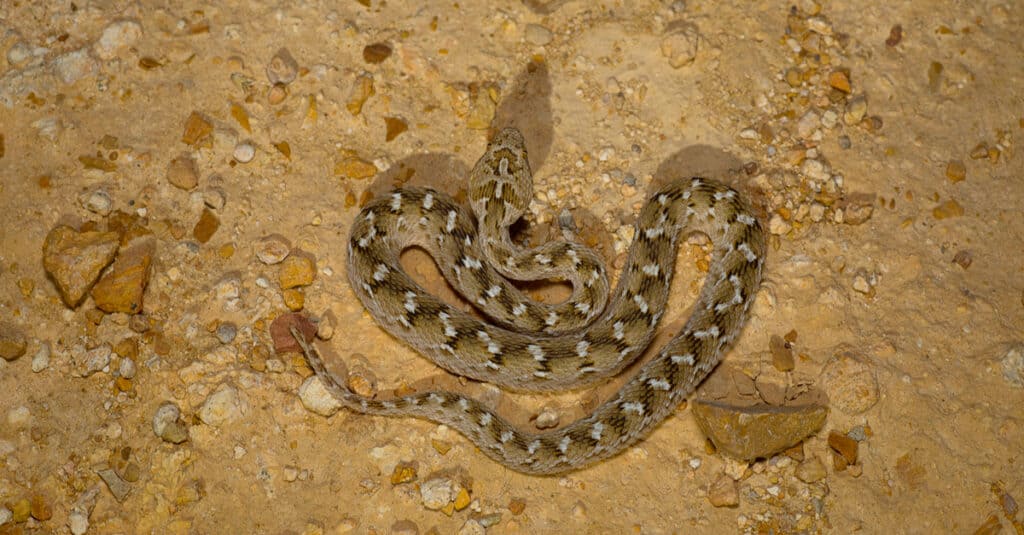
©RealityImages/Shutterstock.com
As of 2022 there are 12 species of carpet viper.
They are:
- E. borkini
- E. carinatus
- E. coloratus
- E. hughesi
- E. jogeri
- E. khosatzkii
- E. leucogaster
- E. megalocephalus
- E. ocellatus
- E. omanensis
- E. pyramidum
- E. romani
E. carinatus, the saw-scaled viper has five subspecies. These are:
- E. c. astolae
- E. c. carinatus
- E. c. multisquamatus
- E. c. sinhaleyus
- E. c. sochureki
The Egyptian saw-scaled viper, E. pyramidum has three subspecies. They are:
- E. p. aliaborri
- E. p. leakeyi
- E. p. pyramidum
These snakes resemble each other and identification can be tricky unless the person knows the snake’s native habitat. They are small snakes that have a pattern of blotches in earthen colors over a lighter or darker ground that’s also earth-colored, though the painted carpet viper and the Mali carpet viper are a little more vivid.
Evolution and Origins
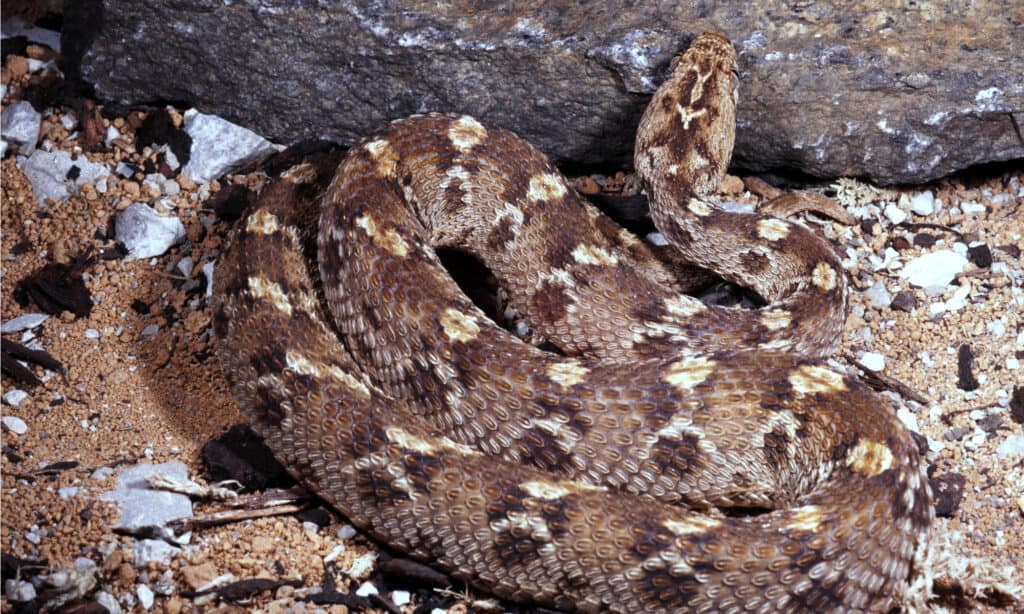
Northeast African carpet viper, Echis pyramidum, small but poisonous viper
©Vladislav T. Jirousek/Shutterstock.com
Echis, also known as saw-scaled vipers or carpet vipers, comprises a group of vipers that inhabit the arid regions of Africa, the Middle East, India, Sri Lanka, and Pakistan. These vipers are known for their distinctive defensive behavior, where they create a “sizzling” warning sound by rubbing specific parts of their bodies together.
The earliest fossil records of vipers date back to the lower Miocene period. However, based on molecular phylogenies, it is believed that Viperidae originated even earlier, tracing its roots back to the early Eocene epoch.
Vipers first emerged in the Old World, and subsequently, pitvipers expanded into the New World, quickly colonizing and dispersing across North, Central, and South America.
Population and Conservation Status
Though scientists don’t know exactly how many carpet vipers there are, they are fairly abundant in the locations where they are found. The conservation status of most is least concern, though the data is deficient for vipers such as the Mali carpet viper.
How To Identify: Appearance and Description
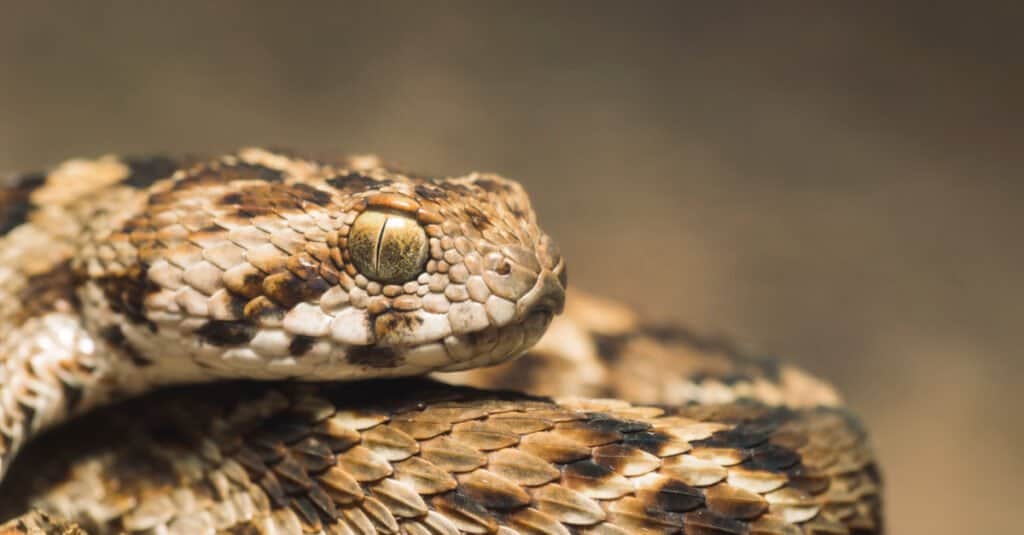
©sushil kumudini chikane/Shutterstock.com
Characteristics to look for in the identification of these snakes are a small, pear-shaped head on a narrow neck, a short round snout, round, large eyes, a short tail, and earth-tone coloration.
They are not large snakes, and even the largest species, such as the white-bellied carpet viper don’t grow more than 3 feet in length. Identification is further helped by examining the snake’s scales.
Most are keeled with a ridge going down the middle. Not only this, the scales on the snake’s side are angled at 45 degrees and are serrated. This gives the snake its other name a saw-toothed viper.
How Dangerous Are They?
Despite their small size and unshowy looks, members of the Echis genus cause not only the most snakebites but the most snakebite deaths on Earth.
They do this because they are both aggressive and easily overlooked. They also live in the same locations where people also live and work. Immediate bite treatment is a must, and these vipers often live in places where modern medical care is hard to come by.
The venom is especially dangerous because it is made up of the four main types of snake venom. One part attacks the nervous system, another attack the cardiovascular system, another the blood, and the last destroys the cells of the body in general.
Behavior and Humans
Carpet vipers are solitary save the breeding season. They’re usually active at dusk or at night, especially if the weather is rainy or humid. During the day they hide in old burrows, holes, logs, or under crags. If the snake lives in the desert, it may just dig into the sand with only its head poking out. On wet days, the snake climbs into trees or shrubs and can often be found there in large numbers.
The way the snake positions its body is another aid in its identification. It often curls its body into a figure 8 and rests its head in the center, which puts it in a good position when it’s ready to strike. Because these snakes are so bad-tempered, they aim to bite and envenomate when they do strike. When they’re about to strike they hiss and rub the saw-edged scales together, which produces a sizzling sound.
As so many are found in deserts, many Echis snakes move by sidewinding, which they perform with surprising speed.
The snakes mate in the winter and the babies are born from spring till late summer. Female E. carinatus snakes give birth to live young, while other snakes lay between 3 and 23 eggs. Their lifespan is on the long side for a viper, and the lifespan of a carpet viper can be about 23 years.
Like other snakes, they help humans by having a diet of pests such as rodents. Medicine has been made from the venom of snakes such as E. carinatus. Echistatin, for example, is an anticoagulant. But carpet vipers are so aggressive and venomous that they demand respect.
View all 235 animals that start with CCarpet Viper FAQs (Frequently Asked Questions)
Are carpet vipers venomous?
Carpet vipers are extremely venomous.
How do carpet vipers hunt?
Like all snakes, carpet vipers hunt by flicking their forked tongues to pick up the chemical trails of their prey. Their tongue then relays the molecules to an organ called a Jacobsen’s organ. Though they are basically deaf, the snake can also pick up vibrations made by prey. It can follow prey or wait until it passes by. Then the viper strikes envenomate the animal and let it go. The prey dies quickly, and the snake moves in to swallow it whole.
Are carpet vipers aggressive?
Carpet vipers are notoriously aggressive. They are responsible for more snake bites than any other snake.
Where do carpet vipers live?
These snakes live in locations such as Africa, Asia, and the Middle East.
What do carpet vipers eat?
Carpet vipers are predators and are not fussy about their diet. They’ll eat large insects and other arthropods such as spiders and scorpions, other snakes, birds, small mammals, toads, and frogs. However, carpet vipers do not seem to be part of the diet of other predators.
What is a carpet viper?
It is a member of the Echis genus of snakes. These snakes have neutral colors and patterns, are relatively small, and rarely grow to over 3 feet in length. However, they are bad-tempered, aggressive, and extremely venomous.
How venomous is a carpet viper?
Despite their size, carpet vipers are responsible for more snake bite deaths than any other type of snake. This includes cobras, mambas, puff adders, and rattlesnakes.
What type of venom does the carpet viper have?
The venom of these snakes is made up of neurotoxins, cytotoxins, hemotoxins, and cardiotoxins. In other words, unless bite treatment is given immediately, the toxins will attack just about every important bodily system. Symptoms include uncontrolled bleeding all over the body, including the brain.
Why does the carpet viper kill so many people in Africa?
The viper kills as many people as it does in Africa because it is aggressive, very venomous, widespread, and easy to overlook. A carpet viper resting in the sand is often camouflaged and very easy to step on. Unlike its distant cousin the gaboon viper, it does not forgive being stepped on and will bite.
Thank you for reading! Have some feedback for us? Contact the AZ Animals editorial team.
Sources
- Britannica / Accessed February 7, 2022
- ITIS / Accessed February 7, 2022
- Wikipedia / Accessed February 7, 2022
- Wikipedia / Accessed February 7, 2022
- IUCN Redlist / Accessed February 7, 2022
- Kidadl / Accessed February 7, 2022
- National Library of Medicine / Accessed February 7, 2022

